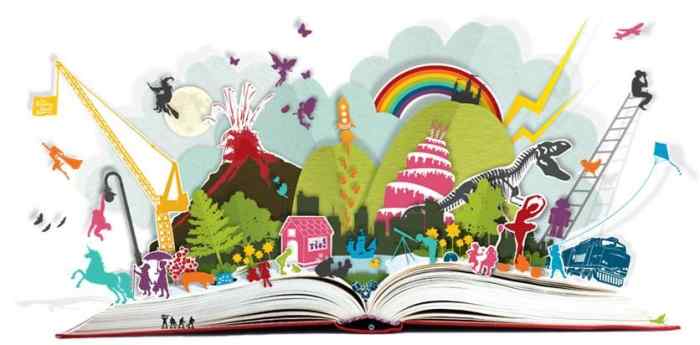Translating Children Books: Difficulties and Reluctances

Babar, Pippi Longstocking, Emil and the Detectives, Heidi, The Wonderful Adventures of Nils and even Asterix and Obelix or Tintin (comic books meant for adults more than children) are works we are familiar with. Some of them have marked our childhood, and those books are available to all thanks to the wonders of translation. Yet how many more translations do you know? They can be counted on the fingers of one hand, and most of them are not recent. They are the exceptions that have managed to make their way into the intense world of Anglo-American literature. But did you know that translations only represent 3% of publications in the UK and the US, and that fiction only makes less than 1% of this figure?
To encounter global and international literature in the UK and the US is a difficult task. Translations are rare and English-speaking authors dominate the market. This issue has been raised in the literary world for a few decades yet it is not noticed by the public. What is the current situation? How much is being translated, and what kind of children literature? Does the shortage of translations express a lack of cultural openness, or are they subject to financial restrictions, set by publishing houses? Yet it is essential that a child reads translations in order to develop, build his own moral thinking and embrace diversity and tolerance.
I. The Current Situation: Publishing Trends and Habits
Today in the United States, very few books are imported from abroad and translated into English. English-speaking authors still dominate the sales, and the bracket of translated foreign books is more than limited. Only 3% of books published are translations, and that number includes all translation – fiction and poetry actually only represent 0.7% 1. It is the same situation in the United Kingdom – in 2015, Literature Across Frontiers put together a report bringing reliable data on the publishing of translations in the UK and Ireland 2. The statistics show that the average of all translations recorded in the British National Bibliography in 2012 is around 3%, and 4.5% of this figure represents literary translations.
In 2008, out of the 90.761 publications that year, only 2.207 were translations, about 2.43%. The UK contrasts with its European neighbours: 46% of books published in Poland are translations, with also 12% in Germany, 24% in Spain and 15% in France 3. Why is the UK’s supply of translated works so low compared to other countries? Are the UK and the US more chauvinistic, culturally excessive or less eager to learn other languages, as R. Buss states? 4
Before exploring the reasons behind this reluctance to open up to foreign publications, it is important to look at the current trends in the translations produced so far. First, translation of fiction only represents 1% or less in both countries – official documents, biographies, informative and lifestyle books etc…. are prioritised. If we focus on the young adult section, the number is even smaller as the US and the UK are the lead publishers in that field. There are also more books translated for young children than for older children.
Adam Freudhenheim, managing director at Pushkin Press, says that ‘there are plenty of publishers doing picture books in translation for children aged five and under […] but no one’s looking at books for 5-10 years old, or 10+’ 5. Hence children from five to ten have less access to foreign books and are only presented with familiar environments. This limits their opening to different cultures at a time where their curiosity about the world and their learning functions thrive.

Translated books also tend to come from neighbouring countries, or countries with similar cultural customs, which ties in with the idea of presenting a recognizable world to the child and limits the ‘international’ market to only a few privileged countries. In the UK, the most translated languages into English are French, German, Spanish, Russian, Italian, Swedish, Norwegian, Dutch, Portuguese and Danish 6, due to their proximity with the UK and their ‘common’ European background. Non-European languages include Japanese, Arabic, Hebrew and Chinese but leaves out developing or ‘less familiar’ countries. Sticking to closer countries not only diminishes the cost and the difficulty of the translation, it also doesn’t risk too much as it does not present something too different or ‘exotic’ that either the child or the parent deciding for the child would get confused by.
Furthermore, it seems that the promotion of some translated books do not reinforce the foreignness of the text, often deleting the name of the translator from the cover. The book is therefore sold as just another story to appeal easily to the local market. It presents an idea of childhood that is not so different from what UK children experience which limits the country’s opening to cultural plurality. Hence the few translations made in the UK are already limited in their practice, their openness and their impact on the public.
II. The Reasons: Gatekeepers, Obstacles and Reluctances
The numerous limits placed on the small amount of translations produced start to explain why the UK is behind other countries regarding its openness to foreign (children) literature but there are also many economic and cultural factors to take into account. First, many gatekeepers stand in the way. Torben Weinrich developed a model defining the categories of people that influence the choice of books children will read. The first ones to act upon the international book market are the publishers, followed by librarians, booksellers, teachers and parents and finally the child. If one of these does not choose to circulate or buy translations, the child has no access to foreign books. Since the publishers are the first ones to choose, they impact the other categories’ choice and prevent customers to engage with a large range of translations.

Publishers are the first gatekeepers as they decide which books to invest in and distribute, following strict budgets. One of their main reasons for not translating is the cost – as Walker Books publisher Jane Winterbotham says 7, it is an economically harder thing to do so the publisher must truly believe in its benefit. Emer O’Sullivan states that since Harry Potter, children publishers choose works with a large potential for merchandising and profit 8hence will not invest in small translations but in established authors, prize winners and books from similar cultural areas, which again limits the spectrum of choice.
Sometimes, they will choose works written in a language known by staff or editors; yet very little British editors speak another language, as the children’s literature expert Michael Rosen highlights 9. They will rely on translators yet give them little time to produce the translation. After, they will edit it according to their customer’s preferences and to limit the cost and number of pages. The original book is therefore changed, its difference lessened. The translator works under stressful conditions and with little economic or creative reward, hence the quality of the book diminishes in order to meet the publishers’ financial standards and almost guarantee commercial success.
Librarians and booksellers also help circulate books and open the child to translated works. Yet Klaus Flugge, founder of Andersen Press, points out that there is a lack of librarians nowadays, due to money shortages 10. He believes that for this reason, and because teachers and parents can’t or won’t always spend time over a book with children, libraries stock more books children can enjoy on their own such as ghost, classroom or humorous stories. Translations are regarded as too ‘alien’ or difficult for children to understand on their own.
Critics also have their impact on the transmission of books and they can help the teacher, parent or librarian select children literature appropriately. But in many cases, as Herbert Lomas highlights 11, there is hardly a review or comment about the translator’s work. ‘A great silence proceeds, not only from the great British public but from the small literary world’. The critics have limited access to translations but they also fail to highlight the work behind a translation when they encounter one. How can these works be made accessible to librarians, teachers, parents and children if critics do not acknowledge their foreign aspect? How can a translator carry on without recognition or reward?
Another issue is the difficult and uncertain nature of the translating process. Publishers do not want to take the risk of producing bad adaptations that result in low sales, incomprehension but also problems with the original author. Edits on translated books are more delicate to make than on original manuscripts as the work has already been accepted in another country. Yet edits are essential in order to adapt to the local public, but they remain very subjective. The Jewish editor who translated Jules Verne’s work eliminated anti-Semitic passages, convinced they were harmful to children. The translator of Robin Crusoe, being Catholic, suppressed the Protestant moral of the book and adapted it to a Spanish context. Where to draw the line between personal choice and adaptation for the public? How far can one adapt without changing the original too much? Should localisation, the adaptation of a text to the reader’s familiar environment, prevail? Publishers do not want to worry about these questions, so they do not invest.
To translate for children is also challenging language-wise. Children are still learning to read and understand, so translations have to be carefully crafted. This can cause problems with specific words or grammar. M. Matsuno states that the use of certain native words for a younger audience can complicate their understanding. This limits the interest towards countries with different alphabets and non-Latin/Western roots.

Yet language is not the only delicate thing to translate – concepts, characters and different customs can be hard for a child to grasp, even from a neighbouring country. Some countries have different conceptions of childhood. One can allow children to learn more crude things than another. For example, Nothing by Jane Teller is very bleak – while it was a Danish success, it was badly-received in Germany. The author says that Scandinavia likes to tell young people how things are as preparation, whereas Germany is more protective. Hence the book was only taken by one small publisher. Children books are representative of the pedagogical, moral and political values of their countries which can clash put in a different context, and discourage publishers and customers to consume them.
The difficulty of language is not the only reason behind the reluctance to translate – there is a great lack of interest in foreign books from the public. The global dominance of English makes both countries largely self-sufficient (the UK can also rely on imports from ex-colonies and the Commonwealth). Lomas argues that the famous British authors (from Shakespeare to Lewis Carroll) made their works about Englishmen and American authors did the same, depicting the American community and reflecting its history(from Steinbeck, Toni Morrison to Fitzgerald). Adaptations perpetuate this tradition because people want to read about themselves, or close to, hence foreign books are either avoided or made less ‘different’.
The lack of interest is also more generally about books – M. Schildt 12 says that before, the only way for the world to come to the child was through books. Today, children have access to internet, television and travel, generally speaking. With technologies, a new childhood grows in Western countries and the child has more in common with the adult (knowledge of computers or consumerist behaviour, for example). Children have more tools to explore the world from home, and books are no longer considered the best medium to do that. Therefore publishers are less inclined to invest into translations.
III. The Importance of Translations: Children’s Encounter with the World
It looks like they are many reasons for the UK and the US not to invest more in translations. Yet they are essential for human bonding and identity building, especially for children, and it is important to make them more accessible. Foreign books further the understanding and emotional experience of cultures, linking people together ‘imaginatively, intellectually and culturally’. The earlier the child is exposed to foreign cultures, the more open-minded he becomes, preparing to take part in a global world. He opens to diversity and people, respecting and embracing differences. Hence translations help the child become an ethical being, acquiring a set of moral values that welcomes cultural plurality and tolerance.

Although internet, travel and media help learn about different customs, literature can have greater impact. Books tell stories – their potential for the unreal and their freedom in creating exciting narratives nurture the child’s curiosity. He is not confronted with real, fixed images but can imagine in his head the world depicted on the page and grow a personal relationship with it. He therefore participates much more as he actively visualises this world to understand it better, completely immersed. That is why the passion and delight for reading still persists. Children are newcomers to sounds and rhythms – they have an intense awareness and sensual relationship with language. For Astrid Lindgren, this allows them to accept the most distant things. A good translator should push their imagination, even beyond his own, for them to build tolerance and shape their own understanding of the world. Therefore books stimulate the child’s moral development, more than other forms, and opening the child to foreign books sensitizes him to cultural diversity.

The lack of interest from publishers and customers, the translator’s poor working conditions, the difficulty of adapting and accepting new languages and the fear of cultural clash explains why the UK and the US do not invest much in translations. Yet they risk to miss out on countless treasures and to confine the UK and the US within their own cultures exclusively. In a global world where people with cultural differences learn to work together, it is essential to invest in books that teach about the world in an intimate way, making the reader actively participate in his learning. This is even more important for children as they are at a stage of individual moral development – to read translations from across the world will open the child to empathy and understanding, traits that contribute to the growth of an ethical being.
What is the future of translating children’s books? No one knows really, but the market has to open up. It will continue to flourish in European and Scandinavian countries, but needs to develop in other countries as well. By diversifying their imports, the UK and the US could give a voice to the misrepresented too, as well as developing their literary scene and supporting their arts and culture financially. Interest for African, Latin American and Asian literature (other than the already successful Japanese manga) could increase, and with a bit more money, these countries could strengthen their literary market and also invest in translated books from both European and non-European countries. With the rise of internet, the translator’s role has changed – but could the internet be used as a positive tool for translation, making the process quicker, cheaper and easier to spread the works across the globe? Only the future will tell.
Works Cited
- Dr. Donahaye, Jasmine, ‘Three percent? Publishing data and statistics on translated literature in the United Kingdom and Ireland’, Making Litearture Travel (UK: Literature across Frontiers, 2012) <http://www.lit-across-frontiers.org/wp-content/uploads/2013/03/Publishing-Data-and-Statistics-on-Translated-Literature-in-the-United-Kingdom-and-Ireland-A-LAF-research-report-March-2013-final.pdf> ↩
- Büchler, Alexandra and Trentacosti, Giulia, Publishing translated literature in the United Kingdom and Ireland 1990-2012 statistical report (UK: Literature Across Frontiers, 2015.),<http://www.lit-across-frontiers.org/wpcontent/uploads/2013/03/Translation-Statistics-Study_Update_May2015.pdf> ↩
- Flood, Alison, ‘Pushkin launches new imprint for children’s books in translation’, The Guardian (2013)<http://www.theguardian.com/books/2013/may/07/pushkin-imprint-childrens-books-translation> ↩
- Buss, R, ‘Rates of Exchange’, (UK: Times Educational Supplement, 1994), quoted in Thomson-Wohlegemuth, Gabriele, Children’s Literature and its Translation, An Overview (UK: University of Surrey, 1998), <http://homepage.ntlworld.com/g.i.thomson/gaby-thomson/ChL_Translation.pdf > ↩
- Flood, Alison. ‘Pushkin’. The Guardian. ↩
- Büchler, Alexandra and Trentacosti, Giulia, Publishing translated literature in the United Kingdom and Ireland, Literature Across Borders. ↩
- A World Beyond Alice, BBC Radio 4, 12 February 2015, 11.30. ↩
- O’Sullivan, Emer, ‘Why Translate Children’s Books’, lecture given at the 2012 IBBY Congress, London ↩
- A World Beyond Alice, BBC ↩
- Flugge, K, ‘Lost Opportunities’, Times Educational Supplement (2 April 1993), quoted in Thomson-Wohlegemuth, Gabriele, Children’s Literature and its Translation, An Overview. ↩
- Lomas, Herbert, ‘Why translate?’ (1981), Books from Finland: A Literary Journal (January 2015), <http://www.booksfromfinland.fi/2015/01/why-translate/>, accessed 6 January 2015. ↩
- Schildt, M, ‘On “The Translation of Children’s Books” from the Viewpoint of a Swedish Children’s Book Editor, Translations of Children’s Books, quoted in Thomson-Wohlegemuth, Gabriele, Children’s Literature and its Translation, An Overview. ↩
What do you think? Leave a comment.











Fantastic article. We need to find ways of getting publishers in the UK and US to find it easy to buy foreign books.
There are beautiful children’s literature around the globe. I suspect lots of publishers would like them but they can’t read them. The exceptionally good independently thinking editors are really good at trusting their gut and using their instinct.
You have written an excellent article Rachel! Beautiful images and great ideas. Your points have flowed well together supported by facts, statistics and analysis. I thoroughly enjoyed reading about this topic.
I have found in the public libraries in Toronto, Canada that from JK to Grade 5 there is a huge amount of world literature. I have read many stories to my kids from world lit. But once the kids move on to Junior High School and High School, I have found the quality and quantity of world lit to go right down. Even the few books that are from international authors have been told from a very Western viewpoint. The only current books I have found is the Survivor series. It is an adventure series about catastrophic global events that my younger son loves. You have certainly identified an educational gap.
Writing translated from other languages makes you see things differently…It isn’t less important for children, but more.
All books are not appropriate for translation into every culture, and while a child does not necessarily notice such issues, parents and educators do.
This. Consider, the race and gender of the characters in the story, the role that these characters play and the social dynamics they share, the topic, double-meanings, and historical baggage (etc).
I do not feel like characters being of a different gender or race would be a problem, as it is how children can learn about new cultures and diversity, through different characters. The topics need to be chosen carefully yes, but opening to new topics can be a benefit and an extra step towards embracing diversity and difference. Double-meanings and historical baggage can be problematic to translate, yet selecting appropriate books and working carefully on the translation would still allow more foreign books to reach our bookshops.
This is true, which is why a lot of work and care needs to go into publishing translations. Unfortunately, publishers are not so keen on putting the necessary work and care which is why they dismiss translations so easily. Therefore it creates disparities within the markets which becomes narrow and exclusively English-speaking, and customers loose on great books.
And although I agree, these books are already designed for children so they are appropriate. To take the time to find solutions to avoid certain anachronisms and deal with the difficulties of language for example would show a real interest in other cultures and facilitate cultural exchange.
We need more commercial successes like German children’s book author Cornelia Funke.
This is vital for readers who are uniquely open to explorations of their own language.
The scale of translated children’s books is terribly small.
We have some bad habits in the English-speaking world. We may be better than anyone at cultural export, but where import is concerned we are a disgrace.
We should make translating books for children something mainstream.
Literary translation is exciting.
Good article but I’m not sure about the conclusion. Translation of children’s literature is finally gaining academic recognition. Hence this article on this publication.
It is gaining academic recognition yes, but this is only very recent and is not a primary focus – still rare to encounter academics talking about it in universities for example. But more importantly, it is not particularly gaining recognition in publishing houses and literary markets, and really not with customers. I hope the academic recognition will raise awareness and help things change in a world that defines itself as being ‘global’.
Great piece Rachel.
Translators are in the weakest position of all – restricted by publishers, intermediary groups and even by the tastes of the children themselves.
Children have a limited world view and life experience which must be taken into account when writing and translating for them.
I agree, but disagree.
English has become a major language and, consequently, its literature has become powerful. The effect of this trend is a reduced willingness on the part of the English-speaking world to import books from countries with other languages, along with a lesser interest in other cultures.
There are lots of good books not written in English.
There’s a strong sense when you get books in translation that people will be scared to read them.
I was brought up on translated books.
English today remains the dominant language of publishing and the language most translated from, but least translated into.
Every text bears the characteristics of the culture in which it was written.
The whole field of literature, including children’s literature, is dominated by the English-speaking countries.
I read lots of books in translation when I was a child and had no idea they were translated.
Translators of children’s books have rarely received the acknowledgement and credit that they deserve.
Great piece! It’s interesting to think of how the Internet affects literary translations, and translating texts from multiple cultures is definitely vital in terms of representation and giving children from multiple backgrounds a well-rounded view of the world.
Living in a world of modern information technology, children have begun to distance themselves from the medium of books. They turn to television, the computer and computer games which provide quick, passive entertainment, unlike reading which encourages active thought and participation.
As a translator of children’s literature myself, I enjoyed and learned from this article.
Shared. We must stress the significance of translations into English as a target language, and the way they influenced domestic production and creation of literature offered to children.
Foreign Children literature has too often been sidelined.
What we need is to make it completely obvious to publishers and others that people don’t care whether a book is translated or not.
An understated advantage of children’s literature is that its succinct vocabulary can be a wonderful way to learn a second language. Those familiar with Alice’s Adventures in Wonderland and hoping to get a primer in Russian couldn’t do better than Vladimir Nabokov’s translation. A key part of great children’s lit (such as The Phantom Tollbooth or Dogstar) is the plethora of puns and rhetoric hidden in the wordplay, and more often than not, that is what gets rent asunder in the translation/editing phase.
What do you think of investing in teaching anglophone children other languages earlier on so that they can bypass publishers (and other gatekeepers) in the search for language cultures outside their own?
I’m glad you asked this – I think it is essential to teach children different languages, and the earlier the better. At an early stage, they can assimilate the language and the accent with ease.
I am 100% behind it and know it works because I have experienced it myself – I am French, born in Paris, lived there for 18 years of my life, and never spoke English at home. But I was in an international/bilingual school and learned to read and write in English at 5 years old. With different methods of teaching, programs to completely immerse children within the English language, supported by American, English, Australian, Scottish teacher… I became bilingual in a matter of 2 or 3 years. From then on, we studied literature – English, American, African, Asian etc. Then we studied Spanish authors, in Spanish classes. Without this opening to different cultures and texts, I would not be where I am now, and I do not see why it would not work for anglophone children.
And yes, by having that power of language, I could choose my own books and try new things. That and thanks to a mother in love with literature and pushing me to read lots of different things, reading me tales from Ancient Greece, Africa, Japan and so on
I grew up monolingual until taking Spanish in high school (as per a typical American education), so I had to work extra hard to gain access to Spanish (with the help of teachers for three years and then living in Spain). I’ve learned French by living in Paris. I wish all children in California (my home state) learned Spanish and English from their first moments in school. We’re a bilingual state. And then they could go from there! 🙂
À bientôt !
It’s great to see this article about Children’s Books in Translation. Outside In World, a not-for-profit organisation, has been working in the UK since 2005 to try and influence and change perceptions in the UK publishing industry about translated children’s books, and although much of what you say in your article is true, there have been some encouraging signs, with many more smaller indy publishers setting up with a translation agenda and there does seem to be much more awareness in the industry generally within the UK. A recent article by Outside In World had a look at what has been happening over the last ten years in this area and is available on their website.
As an American publisher of children’s books I am very interested in translating some of our children’s books to Spanish, but the complexity is that many are in rhyme and therefore the context needs to be translated while at the same time preserving the tempo and rhyme. If anyone knows where to find a translator to do this type of work, I would be most grateful!
What an interesting article, a real eye opener! The very low percentage of translated children’s books in the UK and USA is most surprising. To my mind the main reason for the whole dilemma is a very insular (dare I say arrogant?) attitude towards anything to do with different languages from the dominant one, English . My studies on Bilingualism and its Effect on the Individual, as well as Best Teaching Practice in Second /Third Language Learning and Teaching support a similar view to the one raised, namely that children being exposed to other languages and cultures become more tolerant and accepting of different races/ customs/ attitudes and so forth. By the time they reach the age of seven years they are already aware of in-groups and out-groups, and it is essential to give them every opportunity to learn about other ways of life before that crucial time.
I recall that The Little Prince (Le Petit Prince) is a foreign children’s book that has been translated. Would have been nice if it was mentioned.